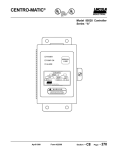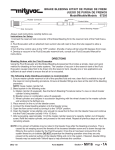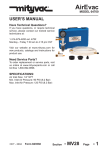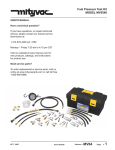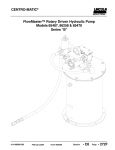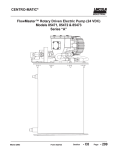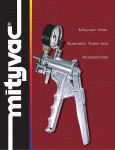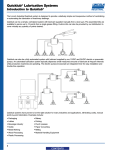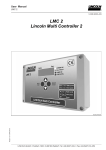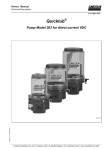Download User Manual
Transcript
PNEUMATIVAC 8.8 Liter/9.3 Quarts Capacity MODEL 07300 8.8 liter Reservoir Tank Brake Bleeder Dipstick Tubes OCT - 2003 Form 822643 Section - MV12 Page - 1 Always read instructions carefully prior to use. Recommended Fluids: Engine Oil, Gear and Transmission Oils, Power Steering Fluid, Coolants, Brake Fluid and Other Fluids. Do not use with gasoline. Using the PneumatiVac away from a Compressed Air Source The PneumatiVac is equipped with an air control valve on the Venturi at the base of the unit and an in-line fluid shut off valve on the hose assembly. This allows the unit to function away from the air source as follows: • Once the compressed air source has been connected to the Venturi, open the air control valve and close the in-line fluid shut off valve. • Maintain a vacuum in the reservoir and then close the air control valve. • Disconnect the PneumatiVac from the compressed air source and transport it to your job site. • Open the in-line fluid shut off valve and the vacuum stored in the reservoir will automatically suction out the fluid. When used in conjunction with the Mityvac® Fluid Evacuator Brake Bleeding Accessory Kit, PIN 07205, this tool can be used to vacuum bleed hydraulic brake systems. The reservoir tank of the Pneumativac is equipped with an automatic shut-off valve to prevent over-filling of the reservoir tank. As the fluid being evacuated flows into the reservoir tank it will raise the float. When the float reaches the shut-off valve, the flow of fluid being extracted will automatically stop. Extracting and Dispensing Lubricants (General) (Motor oil, Gear Oil, Transmission Fluid, etc.) Extracting and Dispensing Motor Oil into a Crankcase 1. Park vehicle on level ground, ensure the transmission of the vehicle is in “neutral” or “park” position and apply the parking brake. 2. Start the engine. Allow the engine to idle until it reaches normal operating temperature. Once this is accomplished, turn engine off. 3. Remove the engine oil dipstick. 4. Select and insert the smallest diameter dipstick tube into the dipstick hole until it reaches the bottom of the oil pan. Connect the main suction tube to the dipstick tube. 5. Insert the opposite end of the main suction tube into the top of the reservoir tank. 6. Connect air hose to the venturi at the base of the PneumatiVac. This will require a male 1/4" NPT fitting (not included). 7. Open the air valve thereby creating a vacuum inside the reservoir tank that will be used to extract the fluids. NOTE: Due to the varying fluid capacities of engines, it may be necessary to empty the fluid reservoir tank and restart the process if the crankcase capacity exceeds 8 liters. Page Number - 2 Form 822643 8. Once the oil has been extracted from the crankcase, remove the main suction tube from the reservoir tank; pour the oil from the tank into a suitable container, and dispose of the oil in an appropriate manner. Rinse out the reservoir tank with clean solvent or engine degreaser. Allow it to dry thoroughly. 9. Refilled the crankcase to the desired level. 10. Run the engine momentarily to circulate the new oil and then recheck the level to ensure that it is at the “full” mark. Extracting and Dispensing Fluid into Transmission Cases and Differentials 1. Follow Steps 1 & 2. (See Extracting and Dispensing Motor Oil into a Crankcase) 2. Remove the transmission fluid dipstick or fill plug. In some applications this may require jacking or lifting the vehicle. Use appropriate safety stands to avoid serious or fatal injury. 3. Select and insert the appropriate diameter dipstick tube into the dipstick fill hole until it reaches the bottom of the transmission pan or gear case. Connect the main suction tube to the dipstick tube. 4. Insert the opposite end of the main suction tube into the top of the reservoir tank. 5. Connect air hose to the venturi at the base of the PneumatiVac. This will require a male 1/4" NPT fitting (not included). 6. Open the air valve thereby creating a vacuum inside the reservoir tank that will be used to extract the fluids. 7. Once the desired amount of fluid has been extracted, close the air control valve to stop the extraction process. 8. Remove the main suction tube from the reservoir tank; pour the transmission fluid from the tank into a suitable container, and dispose of the transmission fluid in an appropriate manner. Rinse out the reservoir tank with clean solvent or engine degreaser. Allow it to dry thoroughly. 9. Refill the transmission to the desired level. 10. Run the engine until it reaches operating temperature to circulate the new fluid and then re-check the level to ensure that it is full. Extracting and Dispensing Coolant into a Cooling System 1. Allow the engine to cool. 2. Remove the radiator I expansion tank cap. 3. Select the largest diameter dipstick tube and insert the tube into the radiator neck or expansion tank. 4. Insert the opposite end of the main suction tube into the top of the reservoir tank. 5. Connect air hose to the venturi at the base of the PneumatiVac. This will require a male 1/4" NPT fitting (not included). Form 822643 Page Number - 3 6. Open the air valve thereby creating a vacuum inside the reservoir tank that will be used to extract the fluids. 7. Once the desired amount of fluid has been extracted, close the air control valve to stop the extraction process. 8. Remove the main suction tube from the reservoir tank; pour the fluid from the tank into a suitable container, and dispose of the fluid in an appropriate manner. Rinse out the reservoir tank with clean solvent or engine degreaser. Allow it to dry thoroughly. 9. Refill the system to the desired level. 10. Run the engine until it reaches operating temperature to circulate the new fluid and then re-check the level to ensure that it is full. Extracting Brake Fluid from the Master Cylinder 1. Clean the exterior of the master cylinder and master cylinder cap. (This will prevent dirt from entering the master cylinder reservoir when the cap is removed.) 2. Remove the lid of the master cylinder reservoir. Prior to inserting the extraction tube into the master cylinder reservoir, be sure that the extraction tube is clean and free of any other types of fluid. Failure to do so would result in contamination of the brake fluid in the hydraulic system and cause potential brake failure. 3. Select the appropriate “dipstick” tube and connect it to the main suction tube. 4. Insert the opposite end of the main suction tube into the top of the reservoir tank. 5. Insert the end of the extraction tube into the master cylinder reservoir. 6. Connect air hose to the venturi at the base of the PneumatiVac. This will require a male 1/4" NPT fitting (not included). 7. Open the air valve thereby creating a vacuum inside the reservoir tank that will be used to extract the fluids. 6. Once the break fluid has been extracted, remove the main suction tube from the reservoir tank; pour the break fluid from the tank into a suitable container, and dispose of it in an appropriate manner. Rinse out the reservoir tank with clean solvent or engine degreaser. Allow it to dry thoroughly. 7. After all repairs are accomplished, refill the system with new, manufacturer approved brake fluid from a sealed container. MAXIMUM TEMPERATURE OF FLUIDS: 176° Fahrenheit, 80° Celsius Page Number - 4 Form 822643 Rubber Connector Tank Connector Control Valve Brake Bleeding Adapter Bleeding Brakes Instructions for Setup: 1. Select the brake bleeding hose and connect one end to the in-line fluid shut off valve. Connect the main connector to the reservoir tank and the universal bleeding elbow to the bleeder screw. 2. Close the in-line fluid shut off valve (handle of valve will be turned 90 degrees from hose). 3. Connect air hose to the Venturi at the base of the PneumatiVac. This will require a male 3/4" NPT fitting that is used with your system (not included). 4. Open the air shut off valve thereby creating a vacuum inside the reservoir tank that will be used to bleed the brakes. The following brake bleeding procedure is recommended: 1. Ensure master cylinder reservoir is full of the specified fluid and new dean fluid is available to top off reservoir during bleeding procedure. Ensure all bleeder fittings are clean at the start of bleeding procedure. 2. Bleed system in the following order: a. Master cylinder (if necessary). See the Bench Bleeding Procedure below if a new or rebuilt master cylinder is being installed. b. ABS controller (if necessary). c. Wheel cylinders and calipers in succession beginning with the wheel closest to the master cylinder and working to the farthest one. 3. Place wrench on the nut of the bleeder screw. 4. Connect brake bleeding adapter onto bleeder screw. 5. Open the air shut off valve by turning it to the “OPEN” position, thereby creating a vacuum required for bleeding. 6. Open the bleeder screw slightly, only enough to cause fluid to flow into the bleeder hose and continue into the PneumatiVac™ (usually 1/4 to 1/2 turn). 7. After evacuating, approximately 1/4 of the master cylinder reservoir capacity, tighten the bleeder screw. Add new brake fluid to the master cylinder so it remains full then proceed to the next wheel. NOTE: A tiny stream of bubbles may be noted in the bleeder hose after the bleeding procedure. This is caused by air seeping around the threads of the loosened bleeder screw and is drawn through the fitting by the suction created by the Fluid Evacuator. Once the air has been removed from the system, these tine air bubbles DO NOT jeopardize the bleeding operation since they are only present at the external surface of the floeder fitting and not in the system. If desired, bleeder fitting threads may be sealed with Teflon® tape to help eliminate this condition. NOTE: When finished using the PneumatiVac, contents should be emptied into an approved waste container. Rinse reservoir with water, or solvent where applicable. Form 822643 Page Number - 5 Bleeding Anti-Lock Brake Systems Always refer to the vehicle’s owner manual or the appropriate service manual for manufacturer’s brake bleeding procedure. The front brakes on most anti-lock brake systems may be bled in the conventional manner. Most hydraulic pump/pressure accumulator units are fitted with a bleeder valve, which must be bled when the system has lost fluid or is being replaced. Some vehicles require that the system be pressurized when the rear brakes are bled. Acura, Ford and General Motors require a bleeding procedure, which uses specialized equipment. Bench Bleeding System Whenever a master cylinder has been removed from a vehicle or a new one is being installed, the master cylinder must be bench bled. Failure to bench bleed is the main reason for unsuccessful master cylinder replacement. Bench bleeding greatly decreases the chance that any air will be caught in the cylinder upon reinstallation. Most manufacturers include a bench bleeding kit with new or remanufactured master cylinders. If this kit was not included with the replacement part to be installed, consult with your retailer prior to installing the new or rebuilt master cylinder on the vehicle. Item Description 1 Brake Bleeding Adapter * Part No. 822559 * Consists of three adapters Page Number - 6 Form 822643 Model 07300 Service Items Item Description Part No. Item Description 1 Vaccum Tube Kit 822599 2 Kit, Exhaust Muffler* 822644 3 Kit, Control Valve 822645 4 Kit, Tube and Connectors 822646 * Consists of three mufflers ** Consists of venturi and connectors *** Consists of base and foot bracket **** Consists of top and overfill float Form 822643 5 6 7 Kit Venturi** Base Kit*** Kit, Lid and Float**** Part No. 822647 822574 822648 Page Number - 7 LIMITED WARRANTYLincoln warrants the equipment it supplies to be free from defects in material and workmanship for one (1) year following the date of purchase. If equipment proves to be defective during this warranty period it will be repaired or replaced, at Lincoln’s discretion, without charge provided that factory authorized examination indicates the equipment to be defective. To obtain repair or replacement, you must ship the equipment, transportation charges prepaid, with proof of date of purchase to a Lincoln authorized warranty and service center, within one (1) year following the date of purchase. LIMITED 5 YEAR WARRANTY (Series 20, 25, 40 Bare Pumps, Heavy Duty and Golden Standard Bare Reels)Lincoln warrants series 20, 25, 40 bare pumps, and heavy duty and golden standard bare reels it supplies to be free from defects in material and workmanship for one (1) year following the date of purchase. If equipment proves to be defective during the warranty period it will be repaired, or replaced, at Lincoln’s discretion, without charge provided that factory authorized examination indicates the equipment to be defective. To obtain repair or replacement, you must ship the equipment, transportation charges prepaid, with proof of purchase to a Lincoln Authorized Warranty and Service Center within one (1) year following the date of purchase. Additionally, in years two (2) and three (3) the warranty on this equipment is limited to repair with Lincoln paying parts and labor only. In years four (4) and five (5), the warranty on this equipment is limited to repair with Lincoln paying for parts only. This warranty is extended to the original retail purchaser only. It does not apply to equipment damaged from accident, overload, abuse, misuse, negligence, faulty installation or abrasive or corrosive material, or to equipment repaired or altered by anyone not authorized by Lincoln to repair or alter the equipment. This warranty applies only to equipment installed and operated according to the recommendations of Lincoln or its authorized field personnel. No other express warranty applies. Any implied warranties applicable to equipment supplied by Lincoln, including the warranties of merchantability and fitness for a particular purpose, will last for only one (1) year from the date of purchase. Some jurisdictions do not allow limitations on how long an implied warranty lasts, so the above limitation may not apply to you. In no event shall Lincoln be liable for incidental or consequential damages. Lincoln’s liability on any claim for loss or damages arising out of the sale, resale or use of equipment it supplies shall in no event exceed the purchase price. Some jurisdictions do not allow the exclusion or limitation of incidental or consequential damages, so the above limitation or exclusion may not apply to you. Americas: One Lincoln Way St. Louis, MO 63120-1578 USA Phone +1.314.679.4200 Fax +1.800.424.5359 Page Number - 8 Europe/Africa: Heinrich-Hertz-Str 2-8 D-69183 Walldorf Germany Phone +49.6227.33.0 Fax +49.6227.33.259 Asia/Pacific: 25 Int’l Business Park #01-65 German Centre Singapore 609916 Phone +65.562.7960 Fax +65.562.9967 © Copyright 2003 Printed in USA Web site: www.lincolnindustrial.com Form 822643








